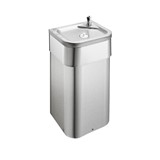IBISWorld general manager (Australia), Karen Dobie, said Australia's alcohol spending is expected to increase by 20.5 per cent over the next five years to reach $39.9 billion by 2017-18 – with the trend towards premium beverages and rising alcohol prices driving growth.
"While Australian alcohol consumption is expected to fall to a decade low of 9.80 litres per capita this year, down 2.4 per cent from 2011, IBISWorld anticipates the move towards more premium products will see alcohol revenue continue to rise," Dobie said.
"In 2012-13, Australians are expected to spend $33.1 billion on alcohol – with $15.9 billion being spent in pubs and bars and $17.2 billion in liquor retailers. Looking towards 2017-18, significant growth is expected across both sectors as the retail environment and consumer sentiment strengthen."
New South Wales accounts for 33.9 per cent of total alcohol spending ($11.2 billion), followed by Queensland (22.4 per cent), which has overtaken Victoria (19.3 per cent) and Western Australia (13 per cent).
Alcohol spending in Australia
|
Category |
2011-12 ($ billion) |
2012-13 ($ billion) |
2017-18 ($ billion) |
Total growth 2012-13 to 2017-18 ( per cent) |
Annualised growth 2012-13 to 2017-18 ( per cent) |
|
On-premises: pubs & bars |
15.5 |
15.9 |
18.0 |
13.2 |
2.8 |
|
Liquor retailers |
16.8 |
17.2 |
19.9 |
15.7 |
3.0 |
|
Total |
32.3 |
33.1 |
39.9 |
20.5 |
3.9 |
On-premises versus at home
In 2012-13, IBISWorld anticipates on-premises alcohol consumption will increase by 2.6 per cent compared to last year, to account for almost half of total alcohol spending (47.6 per cent).
"On-premises consumption – in pubs and bars – has experienced a resurgence over the past year, as consumer sentiment and disposable income has increased and more Aussies opt for a night out on the town," Dobie said.
Changing tastes
"Once a nation of beer drinkers, beer consumption has declined by 15 per cent over the past decade to now account for 37.1 per cent of total alcohol consumption, while wine and spirits have grown in popularity to account for 25.3 per cent and 17.9 per cent of alcohol consumption respectively," Dobie said.
"Australia's beer drinking palate is becoming more sophisticated, with a number of European style beers now being produced on our shores. Traditional full-strength lagers such as VB, Carlton Draught and Tooheys are losing market share in favour of cider and premium beer."
Cider in particular has grown in popularity and is now the outstanding performer in this segment, accounting for 7 per cent of total alcohol consumption, while craft and boutique beers have grown to account for 5 per cent of total production.
Looking towards 2017-18, IBISWorld forecasts this trend will continue – tipping beer to fall to 32.5 per cent of total alcohol consumption, wine to rise to 29.6 per cent, and cider to increase by a further 13 per cent per annum to account for 12.9 per cent of total consumption.
Australian alcohol consumption forecasts
|
Alcohol |
per cent share by value 2012-13 |
per cent share by value 2017-18 |
CAGR* ( per cent) |
|
Beer |
37.1 |
32.5 |
-2.6 |
|
Wine |
25.3 |
29.6 |
3.2 |
|
Spirits |
17.9 |
15.2 |
-3.2 |
|
Cider |
7.0 |
12.9 |
13.0 |
|
RTD |
12.7 |
9.8 |
-5.1 |
*CAGR: Compound annualised growth rate
Fine wine
"Australians are happier than ever to pay a premium for their favourite blend. While Chardonnay remains the most popular drop, accounting for almost half of total wine production, we have seen growth in exotic European wine styles such as Sangiovese, Tempranillo and Pino Grigio," Dobie said.
"Australian wineries have responded to this trend by rebranding themselves as premium to keep up with the resurgence of Old World wines", she added.
White wine continues to dominate, forecast by IBISWorld to account for over 68 per cent of total wine consumption in 2012-13, with female drinkers driving consumption. However, red wine has continued to grow in popularity to account for 31 per cent (up from 24 per cent in 1997-98).
RTD trends
"Ready-to-drink beverages account for nearly 64 per cent of spirits revenue, with producers developing new products to capitalise on changing tastes and preferences – such as the recent trend of RTD cocktails targeted at female drinkers," Dobie said.
Across the categories, demand for top-end products has led to heavy competition from European and US imports – particularly when it comes to pure spirits.
"To combat this trend, IBISWorld expects more Australian manufactures to launch premium spirit products in the coming years," Dobie said.
A global comparison
Australia's alcohol consumption per capita is expected to drop to 9.8 litres after a steady incline for almost a decade, peaking at 10.6 litres in 2006-07.
|
Country |
Consumption in 2012 (litres)lC |
|
Australia |
9.80 |
|
UK |
11.75 |
|
US |
8.61 |
|
China |
5.20 |
|
Thailand |
5.59 |
"Australia's alcohol consumption has slowed down in recent years as Australians become increasingly aware of the dangers of binge drinking," Dobie said.
"The rising popularity of high value products such as cider, RTDs and premium beverages indicate that the industry will not be heavily affected by more sensible drinking patterns."



